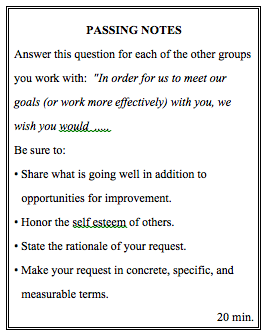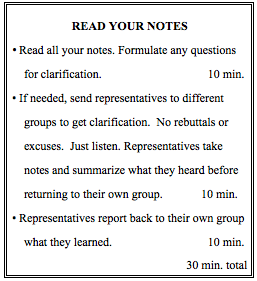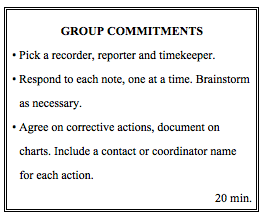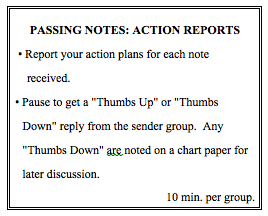“Several of the groups within our organization are interdependent. Productivity suffers because none of the groups seem to understand exactly how their own work impacts the others. And the atmosphere that has developed is more competitive than collaborative. We want to find an effective way to give each other feedback, but we need to learn a technique that is not heavy handed. Do you have any ideas?”
#7 Passing Notes
What is Passing Notes?
Passing Notes is a technique for giving and receiving specific feedback to and from other divisions, departments, groups, work shifts, or even individuals within an organization. The purpose and goals of Passing Notes are very serious but the process is achieved in a light hearted manner.
The ultimate objective of the Passing Notes exercise is to help specific, interdependent groups or even individuals understand what other groups or people need from them in order to do their jobs more effectively.
Passing Notes is not an appropriate tool in highly contentious situations. In those cases, consider a more controlled technique such as Individual Interviews.
When to Use Passing Notes
- When you have groups or individuals that are dependent on each other but have not communicated very well in the past
- When you want to set up a goal-setting session by sharing feedback and information first
- When you want to help groups, or individuals within a group, understand their interdependence and what the others need to work more effectively with them
How to Use Passing Notes
Before the Meeting
1. Plan how you will use Passing Notes in the meeting.
NOTE: This exercise is generally done in a large group session with smaller intact work group breakouts. It can also be done between individuals within a group.
NOTE: You will need to allot approximately ninety minutes for this exercise.
2. Create the four instructional charts or slides you will use. See the charts below for examples.
During the Meeting
1. Present the purpose of Passing Notes. You might say, for example: “We are a group of people who are dependent upon each other for success. But we haven’t taken much time to communicate what we need from each other to be successful. We will take the next hour and a half to exchange information, and then use that information to make plans to help support each other’s efforts better.”
2. Break the group into their specific work groups. Ask each group to write notes to all of the groups that they are dependent on to get their own work done. These Passing Notes need to be specific. This might be introduced as, for example, “In order for us to meet our goals, we need you to …” or “In order for us to work more effectively, we need you to …” Be sure to include positive feedback too, for example “It is very helpful when you ….” Display the Passing Notes guidelines chart or overhead you prepared before the meeting. An example is below.
Coach your groups on how to give constructive feedback, as well as specific guidelines on how to respond to Passing Notes in positive terms. All feedback must honor the self esteem of others, state the purpose of the request, and make the request in concrete, specific, and measurable terms. For example, one note might read: “We need more lead time in order to get you the materials you need when you need them. We would appreciate your communicating with us as soon as you hear from your customers with even an estimate of your needs.” An inappropriate note would read “If you jerks can’t get your act together to pick up the phone, don’t blame us.”
NOTE: Unless you are a neutral facilitator, participate with your group.
3. When finished, ask each group or individual to give the other groups their Passing Notes.
4. Ask each group to read all their Passing Notes. They are allowed to ask for clarification but rebuttals or excuses are not allowed. Post the instructional chart or overhead you have prepared for this section, similar to the one below.
5. When everyone is finished, ask each group to start problem solving the issues expressed in their Passing Notes. This will result in a list of corrective action items that they can commit to. Post a chart or overhead similar to the one below to support you.
6. Next, ask each group to report their action plans for all the notes they received. The group sending each note then responds to the action plans with a “thumbs up” (affirmative) or “thumbs down ” (negative) signal. Coach the groups giving “thumbs down” signals to also briefly explain why they don’t accept the action plan. Plan about ten minutes for every group reporting back. Post an instructional chart similar to the one below during this section.
OPTION: If you have more than three to four groups, or if your Passing Notes came from individuals instead of groups, consider having representatives go back to each group to get one-on-one feedback instead of a group report back.
7. If necessary, ask groups to plan another meeting to work on issues left unresolved between themselves and other groups. If possible, have this “unresolved issues” meeting immediately after Step 8. Dismiss all groups who have no unresolved issues and ask those remaining to make necessary changes to get approval.
NOTE: The “unresolved issues” meeting would follow the steps outlined in 4, 5, and 6 above.
8. Plan a follow up session/progress report, including a specific date and time whenever possible.
In Summary:
Passing Notes is a technique for giving and receiving specific feedback from interdependent groups or individuals within the same organization. The purpose is to help groups or individuals better understand what other groups or individuals need from them in order to do their jobs more effectively. This information is used to plan improvements in work processes and communication.
Before the Meeting
1. Plan how you will use Passing Notes in your meeting.
2. Create the charts or overheads you will need.
During the Meeting
1. Introduce Passing Notes.
2. Break participants into their specific intact work groups. Ask each group to write Passing Notes to all of the groups they are dependent upon to get their own work done.
3. Ask each group to distribute their Passing Notes to the appropriate recipients.
4. Groups read their Passing Notes and ask for clarification as needed.
5. Groups then start problem solving, making a list of corrective action items they can all agree to.
6. Ask each group to report their action plans for each note they received.
7. If necessary, plan another meeting to work on unresolved issues between specific groups.
8. Plan a follow up session/progress report.
———————-
NOTE: If you would like to receive e-mail notification when I post additional techniques, please sign up through this link. http://eepurl.com/KILan You may unsubscribe at any time.



